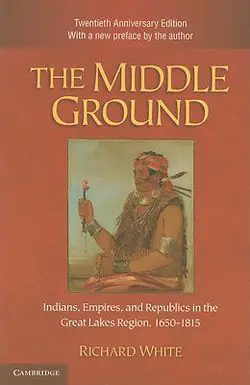The Middle Ground: Indians, Empires, and Republics in the Great Lakes Region, 1650-1815 - Book Review
This article was originally published on Videri.org and is republished here with their permission.
Rich White's The Middle Ground examines the lives of Native Americans and their interactions with Europeans in the pays d'en haut (the upper country where the fur trade took place) from the Iroquois assaults of the 1650s through to the War of 1812. White's detailed book makes a compelling case for the invention, rise, fall, resurgence, and ultimate demise of a cultural "middle ground" between Indians and whites. This hybridization of European and Algonquian social conventions occurred as a result of — and thrived when — neither group had the ability to dominate the other by force. As a result, Europeans and Indians resorted to mediation instead and conducted both their formal and informal affairs using this amalgam of French and Indian ways.
White begins his tale with the chaos that followed the many strikes of the "Iroquois Hammer," and how the resulting displacement and disempowerment of ethnically diverse refugees first enabled the conditions that would make the Middle ground possible - When the French first arrived in the pays d'en haut, they encountered often desperate Indians who were quite often as unfamiliar to the area as they. White goes on to describe the formation of both the French-Algonquin alliance against the Iroquois and the Middle ground. In terms of Indians' cultural impressions, whites go from being manitous (otherworldly spirits) to voices for the "Great Manitou" (Christ) to benevolent fathers (represented mainly by "Onontio," the French Governor.)
White then discusses how the conventions of the middle ground played out over time in various social interactions, from interracial sex and marriage to violence and justice tribunals to commerce and the fur trade. In each case, he notes well how differing social understandings of women's roles, atonement, retribution, gift-giving, etc. between French and Algonquians led to misunderstandings that became part of the cultural matrix of the middle ground. I found this discussion to be one of the more interesting segments of the book, recalling Phillip Morgan's Slave Counterpoint in its study of similar cultural flashpoints.
The book goes on to describe the erosion of this syncretic middle ground after the defeats of the Iroquois (thus obviating the need for the alliance in the first place and helping to create Indian republics that no longer answered to Onontio) and the French in the Seven Year's War (thus replacing the French with English "fathers" who, holding more power in the region, saw less need to mediate with the Indians.) White notes how it is the French that first accelerate this cultural deterioration by "abandoning the politics of the middle ground" and replacing force with mediation as their primary means of diplomacy. This attenuation of the middle ground is exacerbated by the policies of Lord Jeffery Amherst, who decides after the war that the cultural tenets of the middle ground - gift-giving, calumets, etc. - were promoting indolence among the "savages" and mandates European customs be used instead. All in all, it seems the days of the middle ground are over.
But the rise of Pontiac (and his and Neolin's strain of nativist Christianity) and the subsequent attacks on English forts alter the balance of power in the region once again, and allow space for the middle ground to thrive anew: As a result, the British tried to adopt the customs and habits of their French forebears in dealing with Indians (until England grew weary of brooking the expenses that mediation required), while British prisoners fulfilled the function of cultural representatives in various Indian villages.
The onset of Revolution causes even more problems for the middle ground and for Native American villages, now the preeminent political unit in the pays d'en haut, as Americans now enter the equation alongside the British and the disappearing French. White traces how, among other things, Indian-hating among Americans, nostalgia for Onontio among Algonquians, and failing military fortunes among the British helped set the patterns of communication during this tumultuous era.
White concludes his book by examining the decline of the middle ground in the post-revolutionary era - As the Americans amass more power in the East, they choose "imperial benevolence," a policy which aimed to make Indians "culturally indistinguishable" from Americans, as their basis of communication with the fledgling and increasingly dependent Indian confederacy in the pays d'en haut. And as the balance of power becomes more and more lopsided, particularly after the War of 1812, the middle ground disappears, and Native Americans are ultimately reconstructed as alien, exotic "others," as evidenced by the sad tale of the aged Tenskwatawa.
In sum, White's book is quite an impressive synthesis of cultural relations between whites and Indians along the Great Lakes region. I would have liked to hear more about the relationships between seventeenth-century English colonists and Native Americans, but since that's not the focus of his book I can't really fault him for it.
Questions:
- Does Richard White pay enough attention to the cultural differences that exist between various Native American groups? In one sense, the middle ground exists in ethnically diverse Native American refugee camps before the French even show up.
- Are there significant conclusions we can draw by comparing and contrasting the middle grounds of Richard White and Phillip Morgan? For example, White keeps noting how the middle ground was often a result of neither group having a preponderance of force in a given region. How does this relate to Morgan's discussion of master-slave culture in both the Lowcountry and the Chesapeake?
- Similarly, does Allan Kulikoff's treatment of Indian-colonist relations have any bearing on Richard White's argument? Are they complementary? Compatible? Mutually exclusive? (Both seem to make a solid case for mutual misunderstanding being the foundation of cross-cultural relations.)

